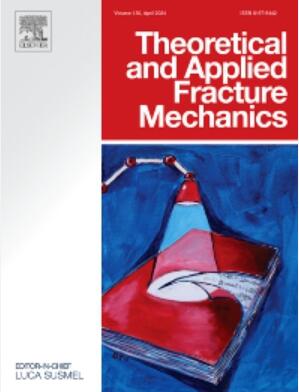平行新竹刨花板的模式 II 断裂特性
IF 5
2区 工程技术
Q1 ENGINEERING, MECHANICAL
引用次数: 0
摘要
本研究探讨了平行新竹刨花板在 RL 和 TL 平面上的模式 II 断裂特性。研究人员设计了八十个端面缺口挠曲(ENF)试样,试样的预裂缝长度和宽度各不相同。采用数字图像关联法(DIC)分析断裂过程区(FPZ)和裂纹扩展阶段的应变变化。采用基于顺应性的梁法(CBBM)和等效裂纹长度计算来确定 PNABSL 的应变能释放率(GIIC)。R 曲线和裂纹增长率曲线显示裂纹在 RL 和 TL 平面上扩展。结果表明,PNABSL 的 RL 和 TL 平面上的模式 II 断裂扩展主要表现为自相似裂纹,但断裂面粗糙不平,并伴有明显的纤维桥接。研究发现,与 TL 面相比,RL 面的模式 II 断裂扩展稳定性较差,这是因为 RL 面的厚壁纤维单元更容易断裂。研究还确定了 PNABSL 的临界应变能释放率,为了解其断裂行为提供了宝贵的资料。本文章由计算机程序翻译,如有差异,请以英文原文为准。
Mode II fracture properties of parallel neosinocalamus affinis bamboo strand lumber
This study investigates the Mode II fracture properties in the RL and TL planes of parallel neosinocalamus affinis bamboo strand lumber. Eighty End-Notched Flexure (ENF) specimens were designed, varying pre-crack lengths and specimen widths. Digital Image Correlation (DIC) was employed to analyze strain variations during the development of the fracture process zone (FPZ) and crack propagation stages. The Compliance Based Beam Method (CBBM) and equivalent crack length calculations were used to determine the strain energy release rate (GIIC) of PNABSL. R curves and crack growth rate curves revealed that crack propagation in the RL and TL planes. The results indicated that Mode II fracture propagation in both the RL and TL planes of PNABSL predominantly exhibited self-similar cracking, though the fracture surfaces were rough and uneven, with noticeable fiber bridging. The study found that Mode II fracture propagation was less stable in the RL plane compared to the TL plane, which is attributed to the easier fracturing of thick-walled fiber cells in the RL plane. The critical strain energy release rate for PNABSL was determined, offering valuable insights into its fracture behavior.
求助全文
通过发布文献求助,成功后即可免费获取论文全文。
去求助
来源期刊

Theoretical and Applied Fracture Mechanics
工程技术-工程:机械
CiteScore
8.40
自引率
18.90%
发文量
435
审稿时长
37 days
期刊介绍:
Theoretical and Applied Fracture Mechanics'' aims & scopes have been re-designed to cover both the theoretical, applied, and numerical aspects associated with those cracking related phenomena taking place, at a micro-, meso-, and macroscopic level, in materials/components/structures of any kind.
The journal aims to cover the cracking/mechanical behaviour of materials/components/structures in those situations involving both time-independent and time-dependent system of external forces/moments (such as, for instance, quasi-static, impulsive, impact, blasting, creep, contact, and fatigue loading). Since, under the above circumstances, the mechanical behaviour of cracked materials/components/structures is also affected by the environmental conditions, the journal would consider also those theoretical/experimental research works investigating the effect of external variables such as, for instance, the effect of corrosive environments as well as of high/low-temperature.
 求助内容:
求助内容: 应助结果提醒方式:
应助结果提醒方式:


